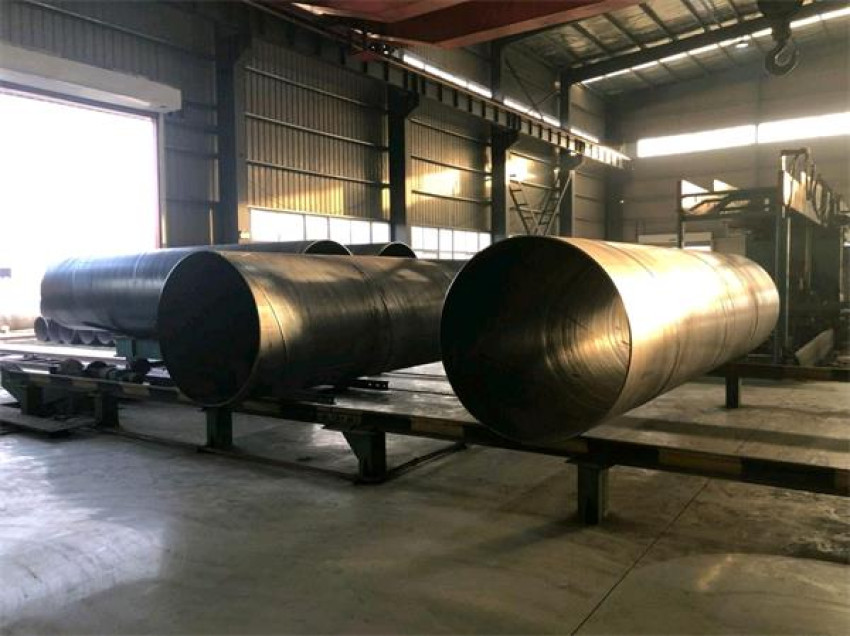
It is a welded tube made of strip steel coil as raw material, extruded at regular temperature, and welded by automatic double-wire double-sided submerged arc welding process. There are four main types of surface treatment for spirals:
1. Cleaning
Clean the steel surface with solvent, emulsion or alkali cleaning to remove all visible oil, grease, dust, lubricant and other soluble dirt on the surface of the spiral steel pipe. However, inorganic substances such as rust, scale, chloride, sulfide, and solder cannot be removed.
1) Surface treatment before cleaning
Remove loose material (excluding oil and grease) from the surface with a rigid fiber brush or wire brush.
2) Cleaning method
(1) First scrape off the thick oil or grease attached to the surface of the spiral steel pipe.
(2) Use any of the following methods to remove the oil or grease left on the surface of the spiral steel pipe.
a. Scrub the steel surface with a rag or brush soaked in solvent. For the final scrubbing, apply a clean solvent, rag and brush.
b. Spray the surface of the spiral steel pipe with a solvent, and use a clean solvent when spraying the last time.
c. Completely immerse the steel surface in the vat containing the solvent. The amount of dirt contained in the solvent used for the last immersion should not have an adverse effect on the coating work.
d. The solvent used in methods a, b, and c can be replaced by emulsified cleaning agent or alkaline cleaning agent, but the harmful residue on the surface of the spiral steel pipe must be washed away with fresh water after cleaning.
e. Solvent and steam can be used for steam degreasing. After cleaning, hot or cold fresh water should be used to wash away harmful residues on the surface of the spiral steel pipe.
3) The scope of application and precautions of the cleaning method.
When cleaning, special attention should be paid to thoroughly cleaning the gaps or rivets.
4) Surface treatment before painting after cleaning
Before painting, use appropriate methods (such as brushing with a brush, blowing with clean and dry compressed air or sucking with a vacuum cleaner) to remove dust and other dirt on the surface of the spiral steel pipe.
Note: Applicable scope of various cleaning methods Cleaning method Applicable scope Notes
(1) Solvent. It is suitable for industrial gasoline, solvent remover of oil, grease, and if the old coating needs to be retained, solvent gasoline, perchlorethylene, soluble dirt and soluble paint can be used to clean the old coating without damage to trichlorethylene, etc. Solvents and wipes should be changed frequently.
(2) Alkaline cleaning agent. Remove saponifiable coating oil, rinse thoroughly after cleaning, grease and other dirt and do a purification treatment emulsion to remove oil, grease and other. After cleaning, residues should be removed from dirt, steam degreased by rinsing off the steel surface. Residue should be rinsed off surfaces after cleaning
2. Tool derusting
Tool derusting includes two types: hand tools (blades, wire brushes, etc.) and power tools (such as power rotary wire brushes, etc.).
1) Derusting with hand tools (St2 level)
It is suitable for removing loose and raised oxide scales, loose rusty old coatings and other dirt on steel surfaces. Retains scale, rust and old coatings that adhere to the steel surface and cannot be peeled off by a spatula.
2) Derusting with power tools (St3 level)
Thoroughly removes all loose or raised scale, loose rust, old coatings and other dirt on steel surfaces. Retains scale, rust and coatings that adhere to the steel surface and cannot be peeled off by a spatula.
3. Spray (throw) shot to remove rust
The quality grade of spray (throwing) rust removal is divided into four grades: cleaning grade, industrial grade, near white grade and white grade. The following are introduced respectively:
1) Cleaning level (Sa1 level):
2) It is suitable for removing loose and raised scale, loose rust, loose old coating and other dirt. After cleaning, there is almost no oil, grease, dust, loose scale, loose scale, loose rust and loose old coating on the steel surface. However, scale, rust and old coatings that remain firmly adhered to the surface are permitted.
3) Industrial grade (Sa2 grade):
Suitable for removing most mill scale, rust, old coatings and other dirt. After cleaning, there is almost no oil, grease and dust visible to the naked eye on the steel surface. However, it is allowed to leave evenly distributed and firmly adhered scale, rust and old coatings on the surface, the total area of which shall not exceed 1/3 of the total rust removal area.
4) Near white grade (Sa1/2 grade):
5) Suitable for removing almost all scale, rust, old coating and other dirt. After cleaning, there is almost no oil, grease, dust, scale, rust and old coatings visible to the naked eye on the steel surface. It is allowed to leave evenly distributed scale spots and rust on the steel surface, and its area shall not exceed 5% of the total rust removal area.
6) White grade (Sa3 grade):
Thoroughly remove scale, rust, old coatings and other dirt. After cleaning, there is no oil, grease, dust, scale, rust and old coating visible to the naked eye on the steel surface, and only very slight traces caused by rust spots, chloride scale spots or old coating are left evenly distributed.
4. Pickling
Generally, chemical and electrolytic pickling are used for pickling treatment. Only chemical pickling is used for pipeline anticorrosion, which can remove scale, rust, and old coatings. Sometimes it can be used as reprocessing after sandblasting and rust removal. Although chemical cleaning can make the surface reach a certain degree of cleanliness and roughness, its anchor pattern is shallow and it is easy to pollute the environment.




